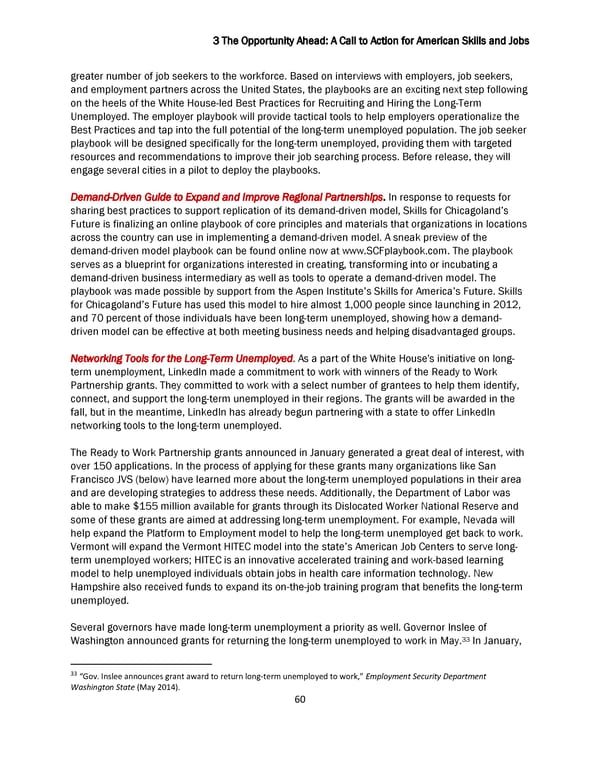3 The Opportunity Ahead: A Call to Action for American Skills and Jobs greater number of job seekers to the workforce. Based on interviews with employers, job seekers, and employment partners across the United States, the playbooks are an exciting next step following on the heels of the White House-led Best Practices for Recruiting and Hiring the Long-Term Unemployed. The employer playbook will provide tactical tools to help employers operationalize the Best Practices and tap into the full potential of the long-term unemployed population. The job seeker playbook will be designed specifically for the long-term unemployed, providing them with targeted resources and recommendations to improve their job searching process. Before release, they will engage several cities in a pilot to deploy the playbooks. Demand-Driven Guide to Expand and Improve Regional Partnerships. In response to requests for sharing best practices to support replication of its demand-driven model, Skills for Chicagoland’s Future is finalizing an online playbook of core principles and materials that organizations in locations across the country can use in implementing a demand-driven model. A sneak preview of the demand-driven model playbook can be found online now at www.SCFplaybook.com. The playbook serves as a blueprint for organizations interested in creating, transforming into or incubating a demand-driven business intermediary as well as tools to operate a demand-driven model. The playbook was made possible by support from the Aspen Institute’s Skills for America’s Future. Skills for Chicagoland’s Future has used this model to hire almost 1,000 people since launching in 2012, and 70 percent of those individuals have been long-term unemployed, showing how a demand- driven model can be effective at both meeting business needs and helping disadvantaged groups. Networking Tools for the Long-Term Unemployed. As a part of the White House's initiative on long- term unemployment, LinkedIn made a commitment to work with winners of the Ready to Work Partnership grants. They committed to work with a select number of grantees to help them identify, connect, and support the long-term unemployed in their regions. The grants will be awarded in the fall, but in the meantime, LinkedIn has already begun partnering with a state to offer LinkedIn networking tools to the long-term unemployed. The Ready to Work Partnership grants announced in January generated a great deal of interest, with over 150 applications. In the process of applying for these grants many organizations like San Francisco JVS (below) have learned more about the long-term unemployed populations in their area and are developing strategies to address these needs. Additionally, the Department of Labor was able to make $155 million available for grants through its Dislocated Worker National Reserve and some of these grants are aimed at addressing long-term unemployment. For example, Nevada will help expand the Platform to Employment model to help the long-term unemployed get back to work. Vermont will expand the Vermont HITEC model into the state’s American Job Centers to serve long- term unemployed workers; HITEC is an innovative accelerated training and work-based learning model to help unemployed individuals obtain jobs in health care information technology. New Hampshire also received funds to expand its on-the-job training program that benefits the long-term unemployed. Several governors have made long-term unemployment a priority as well. Governor Inslee of 33 Washington announced grants for returning the long-term unemployed to work in May. In January, 33 “Gov. Inslee announces grant award to return long-term unemployed to work,” Employment Security Department Washington State (May 2014). 60
 Biden Ready to Work White Paper 7/22/14 Page 59 Page 61
Biden Ready to Work White Paper 7/22/14 Page 59 Page 61